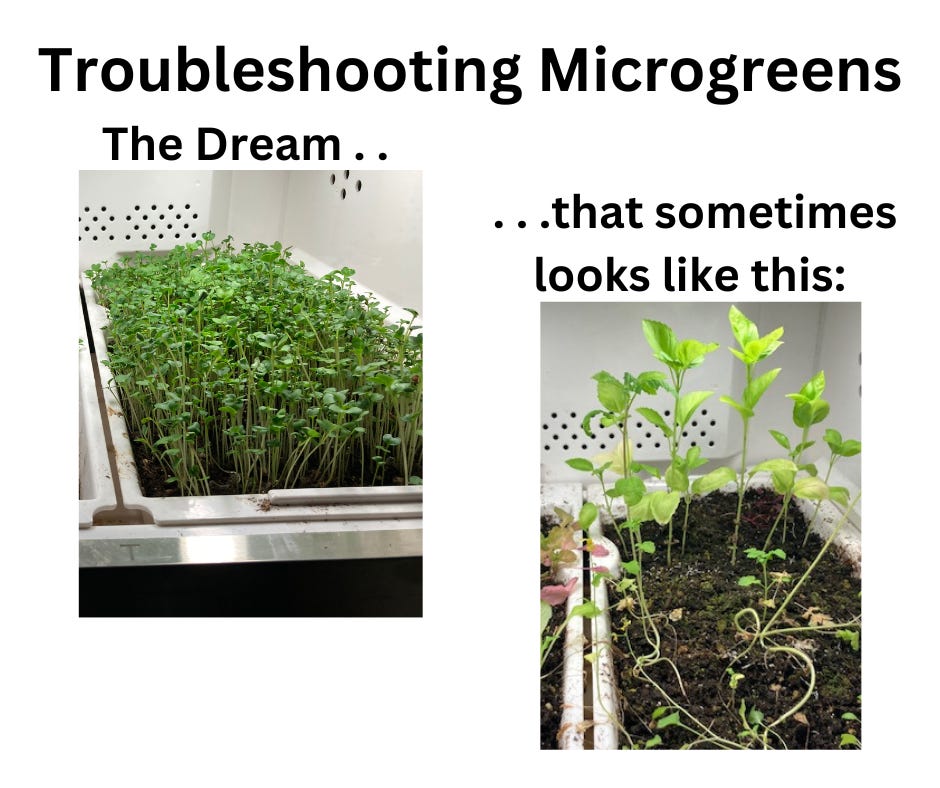Troubleshooting Microgreens At Home (because things don't always turn out as planned!): Part I
From someone who has tried and failed many times on the way to getting better
What could possibly be easier than plants that you sow, grow and harvest within two weeks or less?
Microgreens are the answer to so many home-grown food challenges.
No outdoor space? No problem. Limited time to garden? No problem. Want a wide selection of fresh plants in the winter? No problem.
Except when there is a problem.
Because even though the internet is full of these gorgeous carpets of microgreens, sometimes what you end up with doesn’t match the hype. So what happened here?
Let’s breakdown some of the common challenges of growing microgreens at home so that most of your results are Instagram worthy instead of things that make you say ARGH!

What could possibly go wrong?
When it comes to growing food - the answer to ‘What could possibly go wrong?’ is most often “Every freaking thing and then some!” And, of course, it happens when you least expect it.
Sometimes when you’re starting out with a new growing method, nothing seems to go right. Other times you can produce batch after batch of picture perfect greens and then - Hello? What the heck just happened?
And figuring out what went wrong can be really hard. Gardening can be like that. Growing microgreens can have it’s share of surprises too, all compressed into the short growing windows of weeks instead of months.
Problems you see most often with microgreens:
A tray with few plants
Good growth but only in patches and lots of bare soil
Seeds that sprout and then die
Mold
Fungus gnats
Possible causes and likely solutions
Sometimes you simply never figure out why one batch of microgreens does amazing and another fails. But overall, there are some common problems growing this way that most often respond to the solutions I’m going to outline.
Let’s break these issues down one by one.
1. Few plants in the tray
There are at least four possible causes for low density results when it comes to microgreens: planting too deep, temperatures are too low, poor seed quality, and sowing too few seeds.
Planting too deep: With microgreen trays, you want to fill the tray 1/2 to 2/3 with a good seed-starting soil mix, layer in your seeds, and then cover the seeds by a depth that is 2 to 3 times the seed size.
That means tiny seeds like arugula or basil only get dusted by soil on top whereas big seeds like peas or sunflowers need to be covered by considerably more soil. If you plant tiny seeds too deep - many simply won’t be able to push through and grow.
Temperature is too low: Most seedlings germinate best in the 65-70F (18-21C) range. That means some places in your home (like window sills in the winter) might be too cold to provide for consistent germination. Seed heating mats are a great and cost effective solution. Place them under your trays (or pots) and this problem is solved.
Poor seed quality: Microgreen seeds require the same care in handling and storage as regular garden seeds. That means your seed needs to be stored in a cool, dry place and away from sunlight or heat sources.
The highest quality seed you can get is seed that you save yourself, followed by shipped seed from a supplier, and lastly seed purchased from a store. The reason store-bought seed is the lowest quality is because there are no environmental controls in stores.
To learn how to your own seeds - become a paid subscriber to access Successful Seed Saving 101. This includes a lesson on how to conduct germination tests on seeds. A germination test can tell you if the reason your microgreens are not performing as expected is because the seed quality is too low.
So the solution to this one is buy (or save) good quality seed and store it properly.
Too few seeds: To create the carpet of seeds seen in microgreen photos, you have to sow seeds at much greater density than anything you would do for regular planting.
If you use a standard planting tray (approx. 10 by 20 inches or 25 by 50 cm), then you need to use 1 tsp of small seeds like arugula or basil, 1-2 Tbsp of brassica seeds, 1/2 cup of beets or buckwheat seed and 1 cup of peas, sunflowers or wheat.

2. Patches do well interspersed with bare soil
Patchy germination can be the result of a few different issues.
If you are using a seed mix (and I LOVE the brassica mix sold by Sprout Master!), it may be that one type of seed is failing, resulting in bare spots in your tray. However, this kind of pattern is much more likely the result of poor seed distribution or inconsistent seed depth.
Seed distribution: It can be really hard to evenly distribute seeds across your tray. The best solution I have found is to use an empty spice shaker with appropriate sized holes in the lid to disperse seeds.
Simply pre-measure you seeds (1 tsp, 1-2 Tbsp, 1/2 cup) into your shaker and the use the shaker to disperse the seeds across the tray. Keep shaking until all the seeds are gone (that’s why you pre-measure each time).
Large seeds like peas, sunflowers and wheat all do better if they are pre-soaked in water for about 8 hours prior to planting. This lets them absorb water quickly and results in more uniform germination.
Inconsistent seed depth: This is one of those gardening skills that just takes practice. After you have dispersed your seeds across the tray, then you want to add a light layer of soil on top. Just enough to barely cover small seeds, and more as the seed size gets bigger. Seed depth is usually much less of an issue if the sprouting temperature is correct.
Same time - Next week for Part II
This post is already getting long, so I am going to break here and roll out the last three troubleshooting guidelines next week.
Microgreens are a truly accessible way to produce high quality food any time and any where.
If you are looking for the basic steps to grow microgreens, check out this post:
If you’ve never tried sunflower microgreen - OH do you need to read this post:
If you are looking for the germination test post (it’s a paid post), you can find it here:
And in case you missed it - my top 12 recommendations for the best microgreens ever lives in this post, which has been one of my most popular posts so far:
The Naturalized Human is a reader-supported newsletter that focuses on our mind-body-food connections. Drawing from recent research findings, personal experience, and our natural history as ancient humans living in a modern world, I want to help you achieve your health and wellness goals within a supportive community.
Subscribe to receive TNH in your inbox each week (usually on Friday or Saturday). Paid subscribers get access to more in-depth programs and content.
In the coming weeks, here at The Naturalized Human, we are going to explore:
How each of your senses (Touch, Taste, Smell) contribute to your microbiome
Options for getting that dose of nature inside your own home, when it’s too cold be outside for long
Whether our pets are contributing to our health, or if they are simply mirrors of our inadequate environments and lifestyles
AND - Keep an eye out for some how-to videos that I am working on (for paid subscribers) - I am looking forward to adding some more resources like these to this newsletter in the coming months.








Great article! We did this last year and were pleased with the results. It was fun and tasty. What a helpful Substack this is!
Just what I’ve needed! Thank you, Sue! I’m another to start growing microgreens.